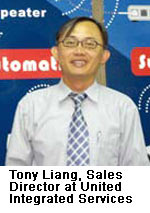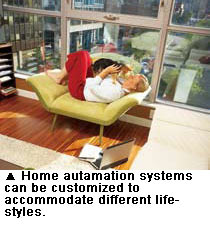Have you ever gotten in a car and wondered if you turned off the air conditioning or heater at home? Have you ever sat at the airport, wondering if the stove was off or the garage door locked? Home automation can provide real-time remote control and management for homeowners. A&S takes a look at the latest home automation features available today.
Have you ever gotten in a car and wondered if you turned off the air conditioning or heater at home? Have you ever sat at the airport, wondering if the stove was off or the garage door locked? Home automation can provide real-time remote control and management for homeowners. a&s takes a look at the latest home automation features available today.
The price tag for home automation was high in the past, so adoption of the technology was not widespread, said Sonny Tseng, General Manager at TechCity Technology. Today, manufacturers are stimulating market growth by lowering unit costs, while maintaining the same features with improved technology.
Intelligent building management has become a must-have technology for modern buildings today, Han Kwang Chu, Director Manager at Taiwan Secom said.
Apart from sophisticated solutions managing different systems, future-proof entry-level systems are available for small homes, Tseng said.
Technology Breakthroughs
Convenience, security, comfort and energy savings are the values of home  automation. Touch screens, remote controllers and Web browsers are convenient means to control home appliances, said Chiu Lu Yung, Director of Cytech Technology. Some companies prefer not to use touch screen panels, since the higher cost increases overall system price, said Tseng.
automation. Touch screens, remote controllers and Web browsers are convenient means to control home appliances, said Chiu Lu Yung, Director of Cytech Technology. Some companies prefer not to use touch screen panels, since the higher cost increases overall system price, said Tseng.
Energy saving is an advantage of home automation. Since the majority of residential energy consumption comes from light and air conditioning, the system can set up a schedule for these appliances to automatically turn on and off to save energy, Jacky Liu, General Manager at Chain-Pro Automation said.
Home appliances such as access control, lighting, air conditioning, audio, remote health care, intelligent closets and kitchen systems can be controlled, said Chu.
As for intelligent office automation, applications that can be integrated are interactive presentation systems, access control, lighting and air conditioning, meeting room setup, network communication, employee management and searches based on user requests, said Chu.
Features
With video door phones, residents, visitors and security personnel can use video chat to communicate with each other. To ensure higher security, video allows tenants to monitor stairways, gates and other areas within the community, said  Wellis Fu, Vice General Manager, Technical Research and Development at Xiamen Genway Security Technology Development.
Wellis Fu, Vice General Manager, Technical Research and Development at Xiamen Genway Security Technology Development.
Alarms can be generated by smoke detection systems, intrusion detection devices and emergency buttons. Security personnel or tenants can receive real-time notifications by phone call, text message or pager. Records of alarms reported can be generated automatically for future reference, Fu said.
Remote control of home appliances is possible with a Web browser, Fusaid. Users can control lighting with a map display by phone call, text message or Web browser.
Video messages can be recorded by visitors and house tenants. The system can be a marketing platform for shops around the community, Fu said.
Based on different security needs, users can choose from different systems, Chu said. An entry-level system features control functions, such as turning on lights, air conditioning and gas. Mid-range systems offer more features, such as alarm control through touch screen panel connected to a central processing server. It controls and adjusts lights, air conditioning temperature and other home appliances. High-end systems have large touch screen control panels — at least 7.5 inches — with local control boxes integrating home controls, said Chu. Control box can also be connected and managed with LED TV screens.
Modular systems allow for system expansion and can support third-party systems, Fu said. Health care modules — such as a bathroom night guide, blood pressure  testing and medication alert systems — are important for households with senior citizens, Chu said.
testing and medication alert systems — are important for households with senior citizens, Chu said.
Customized communication modules are available by request, such as video and audio message features, alarm, security and Internet access. Some manufacturers first develop basic alarm control panels and then customize features according to user requirements, Liu said.
Processors
A powerful central processor allows the system to handle sophisticated features. Standard hardware for home automation has progressed to ARM for its higher processing capabilities. This enables newer systems to feature built-in processing software, such as Linux, with a user-friendly interface, Fu said.
Using a decentralized processing structure can reduce the processor's workload. In a decentralized system, individual modules work independently from the central processor, thereby decreasing manufacturing costs and increasing system stability, Tseng said. When one module fails to function properly, other modules can keep the system running until repair or replacements take place.
Transmission
Currently, there are wired and wireless alarm control panels on the market, with wireless poised to become the trend, Fu said.
Wireless technologies use Wi-Fi for video, Zigbee for mesh networks and 3-GPP for real-time mobile alarm notification. Wi-Fi (IEEE802.11b/g/n) is used in touch panels and network cameras for video streaming, while Zigbee (IEEE802.15.4) is for sensor signal transmission, said Tony Liang, Sales Director at United Integrated Services. 3-GPP is used in 3-G express cards or USB dongles.
A wireless system eliminates the need for cabling, as plug-and-play systems  make installation easy. It is more convenient for users and installers, since they do not need to change batteries often or be restricted by space and power outlets, Liangsaid. Different consoles can be managed with ease, such as touch screens, Web user interfaces and mobile phones. Repeaters can receive signals over long distances, and with transducers, can integrate third-party sensors, Liang said.
make installation easy. It is more convenient for users and installers, since they do not need to change batteries often or be restricted by space and power outlets, Liangsaid. Different consoles can be managed with ease, such as touch screens, Web user interfaces and mobile phones. Repeaters can receive signals over long distances, and with transducers, can integrate third-party sensors, Liang said.
For the United Integrated Services solutions, it sends real-time notifications to up to four destinations by text message or e-mail, Liang said. Its portable alarm control panel has low power consumption, with its battery power for more than 10 hours and a two-year life span.
Selection Criteria
A quality home automation system should have a user-friendly interface, an affordable price, customizable algorithms, standardized API, networking with Wi-Fi or other protocols. It should also be flexible for system upgrades and third-party integration, said Liang.
When choosing an alarm control panel, users should consider whether the system supports wired (UTP) and wireless (WLAN) connections, have low power consumption, emits little heat and install easily, Liang said.
The typical life of a video door phone or an alarm control panel is five to 10 years. Since alarm control panels are not regular home appliances, repairs must be done by specialized technicians, Liu said. Therefore, it is important to consider if the system provider can offer technical support services over a long period of time and would not go out of business before the product's life span.
Most alarm control panels on the market offer one to two years of warranty, said Liu. Installers and users need to look for reliable and reputable manufacturers with innovative products and proven records of reliability, Yung said.
Different regional standards must be considered. For example, voltage in Korea is 220 V, while it is 110 V in Taiwan, Liu said. Certification standards also differ, such as FCC in the United States, CE in Europe, IC in Canada, BSMI in Taiwan, RF and EMI Safety, Liang said.
Challenges
Home automation covers a large product range across different system categories. Determining what appliances and subsystems the system should have is difficult, Fu said.
To ensure all the different modules of a system are stable and properly working together is crucial. Manufacturers need to research what features best suit user needs and can withstand operational stresses the system might have, Fu said.
Currently, home automation companies mainly target construction for sales, Liu  said. As the construction companies are the ones that specify the systems, the systems may not fulfill the expectations of actual homeowners. To continue market growth, manufacturers need to develop products based on user needs.
said. As the construction companies are the ones that specify the systems, the systems may not fulfill the expectations of actual homeowners. To continue market growth, manufacturers need to develop products based on user needs.
Another challenge is end user purchasing power. Luxury apartments are owned by individuals who are usually 50 to 60 years old, with less acceptance for new technology such as home automation, said Liu. More receptive young people are less likely to purchase luxury apartments with sophisticated home automation technology. Therefore, rapid market growth for home automation will have to wait another five to 10 years, Liu said.
One way for manufacturers to expedite home automation market uptake is to educate users and installers about its advantages, Tseng said. Media promotion can also be utilized to encourage adoption.
Future Trends
With the advent of IP, alarm control panel will feature more customization. Different installations with different building functions will require customized systems, Liu said.
More versatile user interfaces such as touch screens, keypads and consoles will be available. There will be a range of third-party interfaces that users can choose from with de facto standards, Yung said. Open platforms will free users to choose products they prefer, said Liu.
Systems will support TCP/IP networking, allowing for third-party integration of products such as door phones. Panel screens will grow larger, up to 10 to 12 inches at most, said Liu. Home automation will become more user friendly, with intelligent functions that automatically detect and integrate sensors, Liang said.